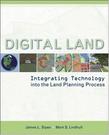数字国土
2006-12
John Wiley & Sons Inc
Sipes, James L./ Lindhult, Mark S.
230
It s your complete guide to design and planning as they relate to land and how digital technology fits into the process. Digital Land, Integrating Technology into the Land Planning Process, explains what digital tools are used to collect, assemble, and analyze information used to assess the suitability of both development and preservation. It also covers scales of planning -- including regional, community, and neighborhood projects -- and shows how digital tools can be used to complete those projects better and faster. Case studies offer sound examples of how digital and traditional tools were used in specific planning projects. This book is ideal if you make or are interested in decisions about the use of land in your neighborhood, community, or region.
AcknowledgmentsImage CreditsPrefaceChapter 1 Introduction Background Framework for Understanding Digital Data Stakeholders in the Planning and Design Process Digital Tools for the Land Planning ProcessChapter 2 Gathering Digital Data The Need for Valid Data Database Management System Software Geospatial Data Democratization of Data Mining for Data Digital Terrain and 3D Landforms Site Surveys Global Positioning System Technology Data Acquisition, Costs, and Management ConclusionChapter 3 Sharing, Storing, and Managing Data Networking Networking Wireless Technology Storage and Backup Disaster Recovery Planning Managing CAD Data Case Study: Sasaki Associates Case Study: Geller Devellis, Inc.Chapter 4 Processing Digital Data Management and Production Importance of the Internet to the Design Community Visualizing the Land Case Study: Burlington Project ConclusionChapter 5 Integrating Digital Data Creating Maps CAD/GIS Integration Processing Images Tools for Urban Planning Case Study: Using Google Earth to Share Geospatial Information Community Mapping Interactive Web Technology: Public Participation in Cyberspace Dynamic Graphics Case Study: Sasaki Strategies Integrating Scientific Modeling and Simulations Case Study: Geller Devellis ConclusionSummary Trends ConclusionWeb ResourcesReferencesIndex
